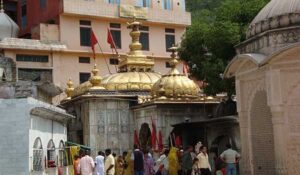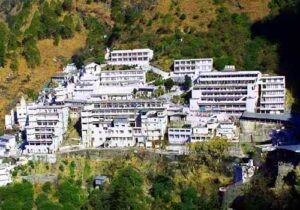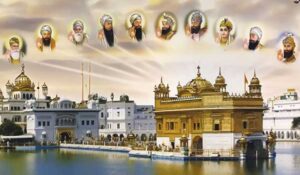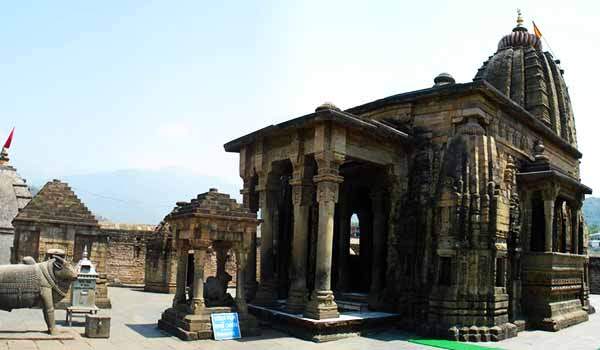 Baijnath Temple is one of most famous temples of Lord Shiva in Himachal Pradesh. Baijnath temple is located at a distance of 16 kms from Palampur in the Beas valley, The Baijnath temple was originally named as Kirangama and the name was changed to Baijnath after the temple was dedicated to Lord Shiva. Apart from the main deity lord Shiva this temple has the images of Goddess Chamunda, Surya Dev (the Sun God), Lord Kartikeya (son of Lord Shiva) and a big structure of Lord Nandi (Carrier of Lord Shiva) in front of the Temple. One of the 12 Jyotirlingas are also located in the sanctum of this Baijnath temple. The temple is imensley popular and people believe that Lord Shiva will free them from all kinds of ailments and diseases.
Baijnath Temple is one of most famous temples of Lord Shiva in Himachal Pradesh. Baijnath temple is located at a distance of 16 kms from Palampur in the Beas valley, The Baijnath temple was originally named as Kirangama and the name was changed to Baijnath after the temple was dedicated to Lord Shiva. Apart from the main deity lord Shiva this temple has the images of Goddess Chamunda, Surya Dev (the Sun God), Lord Kartikeya (son of Lord Shiva) and a big structure of Lord Nandi (Carrier of Lord Shiva) in front of the Temple. One of the 12 Jyotirlingas are also located in the sanctum of this Baijnath temple. The temple is imensley popular and people believe that Lord Shiva will free them from all kinds of ailments and diseases.
A very interesting and spiritual fact of the temple lies in its water, as the water of the temple premises is considered to have curative and medicinal properties. Due to such spiritual and auspicious reasons, the temple draws large number of devotees every year. The ‘Shivratri’ festival is celebrated during the month of March and tourists come to this place to get blessings of Lord Shiva.
Lord Shiva is placed in the form of ‘Lingam’ in the temple . The main sanctum comprises five projections on every side and a tall curved shikhar (spire). The history of Baijnath temple is inscribed on the stone slabs inside the complex. As per the beliefs, Ravana (King of Lanka) had worshipped Lord Shiva in this temple.
In the early 20th century, the temple suffered from an earthquake and the then Raja Sansar Chand made an effort to renovate the temple after the calamity. The temple complex acquired lush green gardens, which makes a perfect foreground to the ancient and unique structure of this temple. Baijnath temple is considered as a part of Indian Heritage, so security arrangements are made here to avoid any unwanted element.
Baijnath temple is constructed according to the Nagri style of architecture. The roof of the temple is in the shape of pyramid with 2.5 sq meters from inside and almost covering the area of 5.5 sq meters from outside the temple premises. The conical shaped dome (Mandap) of the temple gets support from the four artistic big pillars. The temple is a unique example of Kangra architect.
History of Baijnath Temple
According to the inscriptions on the walls of the Temple, the Baijnath Mandir was built by the two native merchants by the name of Ahuka and Manyuka in 1204 A.D. In the porch of the temple, the two long inscriptions give the evidence that before the present temple, there was a shrine of Lord Shiva at the same spot. The present temple of Baijnath is the beautiful example of the early medieval north Indian temple architecture known as Nagara style of temples. The Svayambhu form of Sivalinga is present in the sanctum of the temple and it has five projections on each side and is surmounted with a tall curvilinear of the Shikhara. The entrance to sanctum is from the vestibule that has a large square Mandapa in front with two massive balconies one each in north and south.
There is a small porch in front of that mandapa hall that rests on four pillars in the front preceded by an idol of Nandi, the bull, in a small pillared shrine. The whole temple is enclosed by a high wall with entrances in the south and north while the outer walls of the temple have several niches with images of gods and goddesses. Numerous images are also fixed or carved in the walls. The outer doorway in the porch as also the inner doorway leading to the sanctum of the temple are also studded with a large number of images of great beauty and iconographic importance. Some of them are very rare to be found elsewhere.
Legend of Baijnath Temple
According to Hindu Mythology, Ravana the demon worshipped Lord Shiva in the Himalyas and to please him Ravan offered his heads in the fire of havan. Lord Shiva was pleased and asked Ravana for a wish. Ravana the great demon wanted to be invincible and immortal and also asked Shiva to accompany him to Lanka. Shiva agreed for it and became Ling and asked Ravana to carry him. Shiva also said that he should keep the Ling on the ground during his journey to Lanka. However on the way Ravana had to answer the nature’s call so he handed over the Ling to one shepherd who could not hold it for long and kept it on the ground. Hence the Shiva Linga was established here in Baijnath. Since it was Ravana who brought Shiva Linga to Baijnath, the people here do not burn effigy of Ravana during Dussehra fesival.
Sculptures in Baijnath Temple
The walls of Siva Temple Baijnath are anointed with beautiful carvings and numerous idols of grey stone some of them dating prior to the temple. Some of the idols are very unique and a good study work for the scholars of iconography and archeology. Every square of the temple has absorbing work of stone carving hardly ever seen in northern India. (Click on images to know about unique and gorgeous images.)
GANESHA
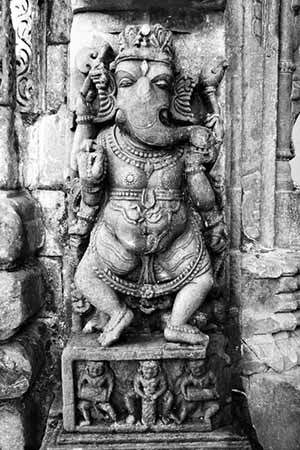 This idol of dancing Ganesha is fixed on the base of the left panel of the porch at entrance. The unique features of the image are that the Ganesha is shown with six arms and with lion and mouse as vahans. The panel in the base of the idol has three figures, each shown beating the drum.
This idol of dancing Ganesha is fixed on the base of the left panel of the porch at entrance. The unique features of the image are that the Ganesha is shown with six arms and with lion and mouse as vahans. The panel in the base of the idol has three figures, each shown beating the drum.
HARI-HAR HIRNYAGARBHA
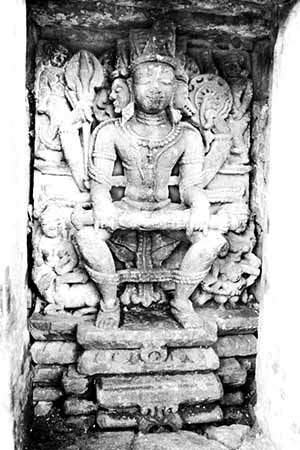 This is an unique composite image of lord Siva and Vishnu with right side depicted as Har (Siva) and left as Hari (Vishnu). The image is three faced; the central image has kreet mukut on the left side and jatta mukut on the right side. Vishnu bears round karanphool (earings) and the lord Siva has diamond shaped earings. On the left vrah face of Vishnu is shown. Of the two hands of Vishnu, the upper one has a chakra and the lower one holds a mace resting on the both knees of the image. On the left of Vishnu is shown Laxmi riding on the garuda. Of her four hands she holds a lotus in upper hand. The objects in other hands are not clear. Of the two hands of Siva, he holds a trident in the upper hand and the scepter in the lower one. The right side of the figure has other face in soumya form of lord Siva bearing a crown of jattajute. On the right side of the figure, there is a four handed image of Parvati riding on nandi. She holds mirror in upper left hand and a book like object in lower left hand. The right hands are not clear. There are two attendant figures on each side at the top of the figure. There is a foliated hallow on the back of the head of the idol. The figure is shown bearing yogpat.
This is an unique composite image of lord Siva and Vishnu with right side depicted as Har (Siva) and left as Hari (Vishnu). The image is three faced; the central image has kreet mukut on the left side and jatta mukut on the right side. Vishnu bears round karanphool (earings) and the lord Siva has diamond shaped earings. On the left vrah face of Vishnu is shown. Of the two hands of Vishnu, the upper one has a chakra and the lower one holds a mace resting on the both knees of the image. On the left of Vishnu is shown Laxmi riding on the garuda. Of her four hands she holds a lotus in upper hand. The objects in other hands are not clear. Of the two hands of Siva, he holds a trident in the upper hand and the scepter in the lower one. The right side of the figure has other face in soumya form of lord Siva bearing a crown of jattajute. On the right side of the figure, there is a four handed image of Parvati riding on nandi. She holds mirror in upper left hand and a book like object in lower left hand. The right hands are not clear. There are two attendant figures on each side at the top of the figure. There is a foliated hallow on the back of the head of the idol. The figure is shown bearing yogpat.
KALYAN SUNDER
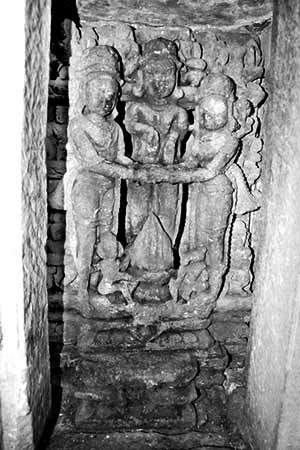 This image depicts the marriage of Siva with Parvati. Siva bearing a crown of jattajoot with a crescent moon, yajnapveet of snake, holding both the hands of Parvati is shown standing in vivah-mandap. Parvati is shown standing on the left of Siva in graceful attire, ornaments and manner. There is a fire altar in the centre of the scene. Four headed Brahma is shown seated on the right side and on the left nandi with human body. In the centre of the sculpture a tall figure of Vishnu is shown performing kanyadaan. On the both sides of Siva and Parvati at the base are depicted Ganesha and Kartikay in dancing postures. On the top of the sculpture from the left are shown Vishnu on garuda, Laxmi on lotus, Parwati and Siva seated on nandi.
This image depicts the marriage of Siva with Parvati. Siva bearing a crown of jattajoot with a crescent moon, yajnapveet of snake, holding both the hands of Parvati is shown standing in vivah-mandap. Parvati is shown standing on the left of Siva in graceful attire, ornaments and manner. There is a fire altar in the centre of the scene. Four headed Brahma is shown seated on the right side and on the left nandi with human body. In the centre of the sculpture a tall figure of Vishnu is shown performing kanyadaan. On the both sides of Siva and Parvati at the base are depicted Ganesha and Kartikay in dancing postures. On the top of the sculpture from the left are shown Vishnu on garuda, Laxmi on lotus, Parwati and Siva seated on nandi.
ANDHKASUR VADH
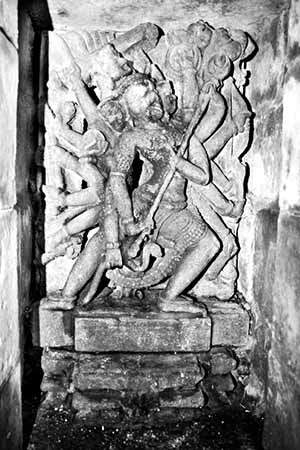 This sculpture shows four headed and sixteen handed virat roop of lord Siva picking up the demon andhakasur on his trident, who was otherwise believed to be invincible on earth and in sky. The blind demon was killed by the lord Siva on his trident in the air. Eight hands on the right side hold objects: 1. trident 2. snake 3. chakra 4. indistinct 5. axe 6. arrow 7. rosary 8. kharag. Objects in the left hands are: 1. rested on chest 2. shool 3. khatak 4. indistinct 5. bow 6. trident 7. shield 8. khatwang.
This sculpture shows four headed and sixteen handed virat roop of lord Siva picking up the demon andhakasur on his trident, who was otherwise believed to be invincible on earth and in sky. The blind demon was killed by the lord Siva on his trident in the air. Eight hands on the right side hold objects: 1. trident 2. snake 3. chakra 4. indistinct 5. axe 6. arrow 7. rosary 8. kharag. Objects in the left hands are: 1. rested on chest 2. shool 3. khatak 4. indistinct 5. bow 6. trident 7. shield 8. khatwang.
Lord KARTIKAY
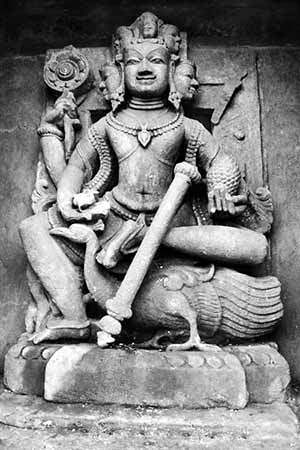 This is most beautiful and expressive idol kept in the niche on the northern face of the temple. Six headed Kartikay is shown seated on the peacock in lalitasan with a blissful main face. Of the two hands on the side upper one has shakti (partly broken) and lower hand has matuling. The lower right hand indistinct object and the upper right hand has a chakra.
This is most beautiful and expressive idol kept in the niche on the northern face of the temple. Six headed Kartikay is shown seated on the peacock in lalitasan with a blissful main face. Of the two hands on the side upper one has shakti (partly broken) and lower hand has matuling. The lower right hand indistinct object and the upper right hand has a chakra.
Lord BRAHMA
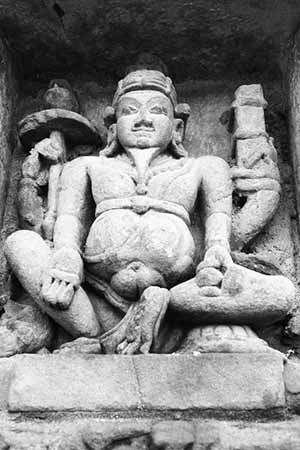 Four handed, pot bellied and bearded Brahma is shown seated in lalitasan bearing a turban. The lower left hand has a pot and the upper left hand holds a book. The upper right hand holds an umbrella like object and the lower right hand is in vard mudra with a rosary.
Four handed, pot bellied and bearded Brahma is shown seated in lalitasan bearing a turban. The lower left hand has a pot and the upper left hand holds a book. The upper right hand holds an umbrella like object and the lower right hand is in vard mudra with a rosary.
SURYA DEV
Idol of Surya Dev sitting on a chariot driven by seven horses is placed on the rear side niche of the temple in the eastern side. Surya Dev is shown holding lotus flowers in both the hands and bearing a kirit mukut, kanthahar, kundals and vaijyantimala.
CHAMUNDA
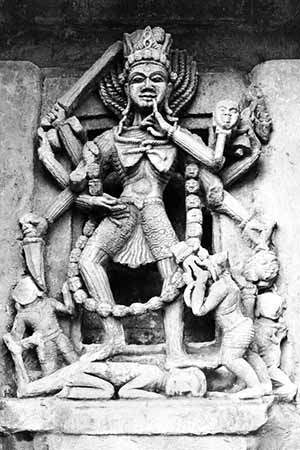 This is a rare idol of goddess Chamunda. The ten handed devi is shown in rage killing a demon while standing on the body of kaal. On the right is shown another under her dagger. The goddess is depicted in usual manner in skelton form, with drooping breasts, bearing mundmala, having a mund in her crown and also bearing a row of munds on her forehead. Her rough thorn like hairs are shown in erected form to express the state of aggression. The posture of her left hand with a little finger resting on her chin in vismay mudra is strange. From the face expressions, goddess appears to be ecstatic of her act. The objects on the five right hands are: 1. trident 2. khapper 3. kharag 4. damru 5. sword. Her left five holds: 1. hand in vismay mudra 2. khatwang 3. shool 4. ganta 5. mund.
This is a rare idol of goddess Chamunda. The ten handed devi is shown in rage killing a demon while standing on the body of kaal. On the right is shown another under her dagger. The goddess is depicted in usual manner in skelton form, with drooping breasts, bearing mundmala, having a mund in her crown and also bearing a row of munds on her forehead. Her rough thorn like hairs are shown in erected form to express the state of aggression. The posture of her left hand with a little finger resting on her chin in vismay mudra is strange. From the face expressions, goddess appears to be ecstatic of her act. The objects on the five right hands are: 1. trident 2. khapper 3. kharag 4. damru 5. sword. Her left five holds: 1. hand in vismay mudra 2. khatwang 3. shool 4. ganta 5. mund.
ARDH LAXMI-NARAYAN
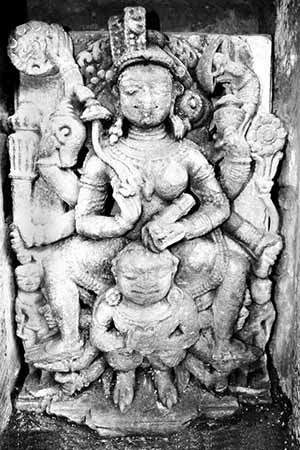 This unique image in northern India depicts composite form of Vishnu with his female counterpart, seated on garuda which is shown ten handed with humane face and body. The right side depicting Vishnu has a kirit mukut and karanphool. Of his four hands Vishnu is holding usual attributes lotus, mace, couch and discuss. However, it is the left side of the image which is unusual and makes it very important and different. It shows female form with a low round crown, round earrings and hair-do in the background. In her four hands she holds a book in front hand, a lotus in the second, a pot in the third and a mirror in the upper hand. Of these book is an attribute of Sarasvati and mirror is an attribute of Parvati. It means the artist has combined the attributes of two goddesses with that of Laxmi. There is a foliated hallow behind the head of image.
This unique image in northern India depicts composite form of Vishnu with his female counterpart, seated on garuda which is shown ten handed with humane face and body. The right side depicting Vishnu has a kirit mukut and karanphool. Of his four hands Vishnu is holding usual attributes lotus, mace, couch and discuss. However, it is the left side of the image which is unusual and makes it very important and different. It shows female form with a low round crown, round earrings and hair-do in the background. In her four hands she holds a book in front hand, a lotus in the second, a pot in the third and a mirror in the upper hand. Of these book is an attribute of Sarasvati and mirror is an attribute of Parvati. It means the artist has combined the attributes of two goddesses with that of Laxmi. There is a foliated hallow behind the head of image.
How to reach the Baijnath Temple
Train facility is available from Pathankot to Paprola-Baijnath which runs on narrow gauge from Pathankot to Jogidernagar.The Nearest airport is Gaggal from Baijnath. The Indian Airlines flies to Dharamsala thrice a week from Delhi
By Road – the Baijnath Temple is very well connected by all weather roads to Delhi via Chandigarh and to Manali via Mandi.The temple is even easily accessible via road from Dharamsala, Palampur, Kangra and all the major cities of Himachal Pradesh.
Tourists can hire private taxis or take state transport buses to reach this holy destination of Himachal Pradesh.
Reaching Baijnath Temple via road, rail or air is fairly easy as it is well connected to the nearby areas as well as the rest of the country.
By Air- The closest airport is at Kullu, positioned 23 kms from here.
Travelers coming by train may use the rail station of Kalka, 90 kms from here.
